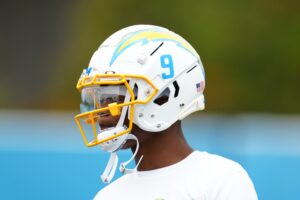Winning your fantasy football league starts with a good draft, and you can’t just rely on being smarter than everyone else. Fantasy projections throughout the internet are fairly optimized, so trying to get an edge based solely on your personal projections isn’t always the best way to go. One of the more popular draft strategies is exclusively drafting wide receivers in the first couple of rounds, commonly referred to as WR early. WR early is a fairly controversial drafting philosophy, but it could be the right choice for you and your team this year.
Before we get started, let’s start with a disclaimer. This article will be using average draft positions based on Fantasy Data’s information. Obviously, there will be some volatility in your personal draft, and you need to take that into account. If you’re drafting in the 5 spot and Saquon Barkley or Christian McCaffrey somehow fall to you, draft them instead. Also, this article is based on a PPR scoring format, which is the predominant scoring system throughout fantasy leagues. If you’re still using standard scoring, this strategy might not apply.
Why WR Early Is the Right Strategy in Fantasy Football Drafts
Find the Value
Last year was a bad year for the WR early philosophy. Anyone that drafted Michael Thomas at the back of the first was happy with their decision, but most of the other early receivers left a lot to be desired. Davante Adams and Tyreek Hill missed time to injury, while guys like Juju Smith-Schuster and Odell Beckham underwhelmed throughout the season.
Because of this, running backs are going early and often in this round of drafting. As of this posting, 10 of the first 12 picks by average draft position are running backs, and only six of the first 24 players off the board are wide receivers.
This is, quite frankly, astonishing to see. If you’re picking at the back of the draft, there is a very real chance that you can come away with Adams and Hill with your first two picks. Both guys have WR1 overall potential, and stacking those two should give you the firepower to win any matchup.
Receivers start going off the board in the third round, but there’s still a very real chance that you could land someone like D.J. Moore, Amari Cooper, or Allen Robinson near the back of the third. All of these guys have top-10 potential, so going WR early could land you three elite players throughout the season.
Risk Mitigation
Everyone drafts differently, but generally speaking, you want to establish a safe floor with your early picks so that you can take high-upside swings in the later rounds. It’s no secret that wide receivers are generally safer than running backs, so going WR early will actually help accomplish this goal.
The ideal fantasy running back is a factor in both the receiving and running game, which means they’re constantly touching the ball. However, receiving that many touches increase injury risk, which means you have a higher chance of needing to find a replacement midway through the season. Obviously, wide receivers have their own injury risks, but those risks aren’t nearly as severe.
Historically speaking, predicting carries is a lot harder than predicting target share. While neither is 100% accurate, carry percentage tends to fluctuate at a higher rate than target share. In real life, the running back position is somewhat replaceable, as most of that production is due to the blocking and play calling. If your running back gets hurt and misses time, there is a very real chance he never gets his job back. Receiving work, meanwhile, requires an established connection between quarterback and receiver that a backup can’t magically replace.
So Who Do I Draft?
Running backs are being overvalued, and elite wide receivers currently represent massive value in the early rounds. This trend holds true throughout the first three or four rounds, which means you could fill up your receiver and flex positions for pennies on the dollar. However, at some point you will have to actually draft a running back. Passing on early talent isn’t fun, but there are a few intriguing late- and mid-round options.
Because you already drafted tons of great wide receivers, you don’t need a stud at running back. You could get by with a volume-dependent guy that won’t you any weeks, but won’t lose too many either. The best guy to fill that need is Chicago Bears running back David Montgomery. Montgomery is in complete control of Chicago’s backfield and should be a three-down player. While Chicago’s offense won’t be the best in the world, he’s a lock for 200-250 carries and should see a sizable role in the passing game. He’s currently going off the board in the late fourth/early fifth and should outproduce his ADP.
Every single year, fantasy football drafters tend to overvalue rookie production. While a new name is obviously exciting, young players tend to need some time before they usurp the established veterans. This is especially true for 2020, as it’s looking like there won’t be much of a preseason. Because of this, current backfield leaders like Mark Ingram, Ronald Jones, Marlon Mack, and Damien Williams are being completely overlooked. They’re going to receive a good amount of work, at least in the early part of the season.
These guys won’t singlehandedly win you a fantasy league, but they won’t need to. With all your receiver talent, you’ll only need solid play out of your running backs.
Main photo:
Embed from Getty Images






